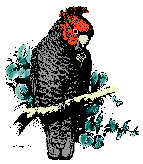Good morning COG/Canberra Birds members and chat line subscribers, a reminder that the monthly COG/Canberra Birds meeting will be held tomorrow evening Wednesday 9 April from
7:30 pm at our usual Canberra Girls Grammar School venue. However, please note the changed access arrangements which will be in place for 2025 while the construction in the Gabriel Drive parking area continues.
The amended map can be accessed through the following link
COG monthly meeting location - Canberra Birds.
Everyone is welcome so please come along to hear about two different aspects studying the White-winged Chough as well as tthe little-known roosting habit of the Noisy Friarbird.
There will be the usual raffle, and you will also be able to enjoy a cup of tea or coffee after the meeting.
Jack Holland
The April 2025 meeting will be a normal face-to-face one held at our usual venue. As COVID is still widespread in the community attendees should heed social distancing and
good hygiene practice etc, and use their common sense and stay home if they have COVID symptoms. Mask wearing is recommended.
Chun-Chieh Liao -
Vocal communication in highly social White-winged Choughs: How do they stay safe and stay together?
Brendah Nyaguthii Nyagah -
Beyond breeding: Spatial and social structure of the White-winged Chough during the non-breeding season.”
Michael Lenz -
Where do Noisy Friarbirds sleep? …a puzzle finally put together (sort of)…
Please note that construction is still occurring around the Gabriel Drive parking area, and access to there is still not available. However, for 2025 the access gate and
parking spot has changed. Entry and exit are now from the main gates on Melbourne Ave which automatically open and close. The Entry gate will be open, so please drive through and park in the main parking area to your left. Once parked proceed to the Multi-media
Theatre (MMT) using the more direct route in the amended map to that provided by the Canberra Girls Grammar School – see
COG monthly meeting location - Canberra Birds.
This is roughly perpendicular to Melbourne Ave. Keep the Admin Hub, Reception and School Shop to your right and then proceed along a relatively flat and straight broad path
keeping the columns to you left. Near to the end, go left up the 3 m wide steps, turn half right and you will find an open glass door. Go through this, across the empty room and past the toilets, and then enter the MMT either through the bottom MMT door
or go further along and up the steps where you reach the usual entry door.
Though it is well lit, as it will be dark before and after the meeting, a torch for finding your way to the MMT and back to your car is recommended. The Exit gate is on a
sensor pad, so please drive up to the gate and it will open for you.
There will be three presentations this month, the first two normal length short presentations and the third a slightly longer one.
The first two will be by
Ph D students from the Research School of Biology at the ANU, on two related aspects of the White-winged Chough behaviour.
First will be
Chun-Chieh Liao on “Vocal communication in highly social White-winged Choughs: How do they stay safe and stay together?”
To maximise the benefits of group living, social animals must maintain cohesion and coordinate their activities. But how do they make consensus decisions and stay
together, especially when groups consist of individuals with different needs and abilities? Communication is key! In this talk, Chun-Chieh will explore the rich vocal world of a highly social bird species - the
White-winged Chough. He will discuss their alarm calls, the development of antipredator responses, and the “lost calls” that help group members reunite.
Second will be
Brendah Nyaguthii Nyagah on “Beyond breeding: Spatial and social structure of the White-winged Chough during the non-breeding season.”
There is a need to understand how seasonality impacts the social structure of groups during periods of increased movements. Individual or collective movement of
animals can be influenced by weather conditions that alter the resource abundance, e.g. periods of drought and winter, which will require them to expand their range and move to new areas. Increasing movements increases the rates of contact with conspecific
neighbours and chances of being in contact with other groups. In this talk, Brendah will present about the
White-winged Chough movement and home ranges to better understand the role of changes in space use driving patterns of social contact among other groups.
The third speaker will be
Michael Lenz on “Where do Noisy Friarbirds sleep? …a puzzle finally put together (sort of)…”
The
Noisy Friarbird has the status of ‘common breeding summer migrant’ in Canberra. Observations from Canberra show that only when breeding will they sleep at their nest site, at all other times at a communal roost. Michael will report on his observations
of their flight path and counts over several years to support this conclusion. Communal roosting is a basic trait of the species. The behaviour of the birds while going to and coming from the roost can explain why this feature of
Noisy Friarbird biology has gone largely unnoticed for so long.

